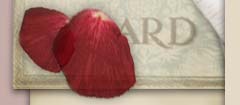|
Home > Stories > Ann (nee Biles) Johnston
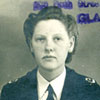 |
| Click for larger image. Ann in a photo taken in 1944. |
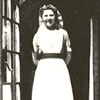 |
| Click for larger image. Ann in her nurse's uniform. |
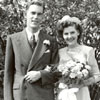 |
| Click for larger image. Ann and her husband Jack Johnston at their wedding in 1947. |
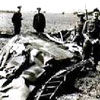 |
| British soldiers collect the wreckage of Hess's Messerschmitt 110 after his parachute descend over Scotland. Source: Willy Brandt Foundation Website |
| Listen to the BBC Broadcast of a local's account of Hess' unexpected arrival in Scotland. |
Ann Johnston was born on December 8, 1922 in Glasgow, Scotland. When war was declared, she joined the nursing sisters where she did her training at Mearnskirk, near Glasgow. On May 10, 1941, she had an unexpected encounter with Rudolf Hess, Hitler's right hand man.
When the War started, it was suddenly like “boom”. Everything changed. Every house had to have “blackout curtains”- no lights could be seen anywhere. The headlights on cars were the size of a quarter. Part of our rock garden was torn out and made into an Air Raid Shelter. My parents spent every night there during the war. One night the bombing was so close that every window in the house was blown out.
I had just finished High School, so was automatically conscripted. No teenage life for us. I had a choice of the Army, Navy, Air Force or Nursing. If you couldn’t decide, it was Munitions Factory. I chose nursing. Andrew was exempt, since he was an engineer working in my dad’s factory making Invasion Barges, and other things pertaining to the War. Alastair, just graduated from Agricultural College (my dad had bought him a farm), was also exempt. At that point, Jock was too young.
I started my training at a hospital called, Mearnskirk-about ¾ hour away from home. It had been a TB Hospital, but had been taken over by the Navy. Every ward was a separate Pavilion. Nursing quarters were also there. I was placed in Pavilion 4. - all Naval Officers. I really enjoyed my course…..but such sad sights. One grew up quickly.
One night at Mearnskirk, the phone rang. A German plane had landed in a farmer’s field. It had one person in it. My buddy and I went out with the ambulance, and found this guy on the ground, the farmer standing over him with a pitch fork. It turned out to be Rudolf Hess, one of Hitler’s top men . He was looking for the Duke of Hamilton - thinking he might be able to stop the War. We brought him to Mearnskirk with a broken ankle. He had that fixed, and then was sent to a castle in Scotland, where he stayed until the war ended. We knew that if he stayed in Mearnskirk, spies would know. German spies were everywhere. This could have caused the hospital to be bombed.
I was a part-time ambulance driver at a port called Greenock, about an hours drive from
Glasgow. They would bring the wounded there, most of them so young, without legs, arms, some with beriberi, since they had been prisoners of the Vichy French in Africa. They were just like skeletons, and some very confused and angry. They would steal for food, and we would have to be very careful, just giving drinks of water, or Jell-O until their stomachs were really ready for food. One night, Jimmy Stuart Monteith came in. We had gone to school together. He had been look-out, using binoculars. He was shot and lost his right eye and his hand.
I met my first husband, Ralph Lawrence when he was a patient. He was 1st Lieutenant of the Tribal Class Destroyer, HMCS Athabaskan. Some of the patients on the medical ward were able to go out. On my day off, I’d take them to my home. My parents always welcomed them. Ralph was one of them. Before he returned to the ship, we were engaged.
Ralph did not want to get married until the assigned tasks for the Athabaskan were less risky. At the time we were engaged, Athabaskan was on convoy escort duty from Murmansk to Scapa Floe, in the Orkney Islands. In 1944, Athabaskan was assigned to what was believed to be the less risky English Channel. Ralph received a 48 hour leave and we were married in my church, on April 17, 1944.
Ralph had mentioned Jack Johnston to me, said he was his brother’s best friend, and that Jack was in the Air Force, stationed in England. Ralph asked him to be best man at our wedding. Jack was not able to get leave, however, so my brother, Andrew did the job.
Ralph returned to his ship and twelve days later, on April 29, 1944, during a night battle off the French coast, the Athabaskan was torpedoed and sunk. There were some survivors, but Ralph went down with the ship. I just could not return to the hospital afterward, so was transferred to a Rehab Hospital in Southern Scotland.
I had never met Jack, but he started writing to me. One time, he was on leave, and stayed several days at my home with my parents. He wanted to meet me.
On my day off that week, he came by train to Barr Hill, and we spent the day together. That was the only time I had seen him until my visit to Canada after the War ended.
War ended in 1945. In April 1946, I was invited by the Canadian Navy to assist in the launching of the second HMCS Athabaskan. This took place in Halifax, N.S. I sailed from Plymouth, England on the Aquatania traveling as a War Bride. The commander of the Ship met me in Halifax and I stayed a week at his home. I then traveled by train from Halifax to Fredericton to meet Ralph’s parents. They were wonderful people. I spent 8 months with Ralph’s parents. They actually, brought Jack and me together. Unknown to me, they had insisted that Jack should show me around, even taking me to the Encaenia (end of the term) dance at UNB. Jack had started taking forestry there when the war was over. I stayed with Ralph’s folks until December, as I wanted to go to Scotland for Christmas. Jack and I became engaged before I left Canada.
He wanted to come to Scotland to be married, however traveling so soon after the War was unpredictable, and he couldn’t miss UNB. My parents knew that I was coming, however my dad insisted that I not come by plane. Nevertheless, that is what I did. I went by train to Montreal, flew to Prestwick and landed in Goose Bay for a few days. I returned to Canada in May. Jack met me in Montreal, took the night flight to Fredericton, arrived at 12 pm and got married at 2 pm. Paul Lawrence was best man.
In January 1948, my mum, dad and Jock came to visit. Jock had just arrived in Scotland. The War was still going when he turned 16, so he had enlisted with the RAF, and ended up parachute jumping with the “Wavels” army in India. I was pregnant with twin boys. They were born prematurely, and died April 11, 1948.
After graduation from UNB Forestry Engineering in 1948, Jack and I moved to Bridgewater, N.S, where he had a job waiting at Hollingsworth and Whitney. We settled there and raised our three children who were born there, Sandra (1950), Keith (1953) and Blair (1961).
We returned to Fredericton, N.B. in 1965 when Jack accepted a position with the Federal Dept of Forestry. Our children are now married, and only Sandra lives in N.B. Jack passed away at the Veterans Health Facility in Fredericton on October 13, 2004 at the age of 80. He had been a resident there for 3 years.
Back to the top
|
 |


